Today we’re taking you on a beautiful and diverse tour of Andalusia. Andalusia is a very special place on earth, as its diversity leaves little to be desired. Whether you’re looking for a beach holiday, sightseeing, an Andalusia tour, or an active holiday – the various regions of Andalusia offer fantastic destinations, most of which can be easily reached by bus, car, or train. In this article, we’ll provide information, tips, and insights.
The Andalusian coast includes more than 400 beaches on four different stretches of coast: Costa del Sol, Costa de la Luz, Costa Tropical, and Costa de Almeria. There are beautiful national parks for hiking, climbing, or even skiing. And there’s also plenty of cultural opportunities. Granada with its Alhambra, Cordoba with the Mezquita, Malaga and Seville as well as the many small white villages along the Ruta de los Pueblos Blancos – simply perfect places for excursions in the surrounding area.
We spent a month in the southernmost part of Europe and explored the most diverse highlights of Andalusia. We’ll reveal our highlights and show you some of our most beautiful snapshots. Sit back and be inspired!
- 1. Getting to Andalusia
- 2. Best time to travel to Andalusia
- 3. Booking a rental car
- 4. Long-distance buses and trains
- By train through Andalusia
- By bus through Andalusia
- Important bus connections
- 5. Book accommodation
- 6. Our highlights of the Andalusia tour
- The great city of Seville
- The white village of Vejer de la Frontera
- The beautiful city of Ronda
- On the beach in Conil de la Frontera
- Viewpoints at Cape Trafalgar
- Detour to Gibraltar
- Chic Marbella
- Our favorite Tarifa
- Detour to Malaga
- 7. Tours and excursions
- 8. Costs – Andalusia tour
1. Getting to Andalusia
By plane: The best way to reach Andalusia is via the airports in Malaga, Jerez, Granada, and Seville. Gibraltar airport is only served by flights from Morocco and England. With low-cost airlines like Ryanair, Easyjet, and Vueling, you can reach one of the aforementioned cities within 2 to 3 hours. Flights are often available for as little as €20 one-way, including hand luggage. We booked our outbound flight to Seville and our return flight from Malaga.
A return flight to one of the aforementioned cities is also an option. From there, you can continue to the various highlights by rental car, train, or bus before returning to the starting point. A round trip through Andalusia is a great option; rental cars are very affordable in Spain.

By car: Those planning to travel by car should, above all, allow plenty of time. The driving time alone is 22 to 26 hours. However, such a trip would be worthwhile, as the scenic diversity is truly worth seeing: passing through southern France, the Pyrenees, rugged coastal landscapes, and the desert-like areas of central Spain. The journey itself is a small adventure in itself.
You should note, however, that there are toll roads in both France and Spain. You shouldn’t ignore this when calculating your costs. In Andalusia, however, there’s usually a free autovia (highway) connecting these roads. The speed limit here is 120 km/h, 50 km/h in towns, and 90 km/h on country roads. National and international driving licenses are accepted in Spain.
2. Best time to travel to Andalusia
If you want to avoid the tourist crowds, you should definitely travel in the off-peak season. While the mild climate allows you to travel through Andalusia year-round, it’s probably less fun during peak season when temperatures and tourists are at their peak. If you enjoy climbing and hiking, spring and autumn are particularly good times. It’s usually far too hot for that in summer anyway. Interested in a beach holiday? Then the period from May to September is best.
For us, the months of April, May, September, and October are the most suitable. Low accommodation costs, fewer tourists, and milder temperatures. Many great festivals also take place in Spain in spring, such as the Feria de Abril in Seville, the Feria del Caballo in Jerez, or the Patios Festival in Córdoba.
During the peak season, between June and August, Andalusia gets really busy! Not only foreign tourists come; Spaniards themselves also come on vacation and like to spend their days on one of the numerous beaches in their own country. The many highlights are also very busy during the peak season. During the day, temperatures can reach 30 degrees Celsius and more.
The low season begins in September, although Andalusia is still quite busy even then. Few visitors are usually seen until November. You can also have bad luck with the weather in September. Until the end of October, however, it’s usually warm and sunny. In November, however, you might be caught off guard by heavy rain for a week. The off-season is ideal for outdoor activities and the mountains. Autumn is also a great time for surfers.
3. Book a rental car
With a rental car, you can drive through Andalusia in a relaxed manner. The good thing is that rental cars are generally very affordable in Spain. When booking, it’s important to make sure you choose the “full/full” fuel option and “no excess.”
We booked a small retro Fiat 500 for our round trip. It cost us just €79 for a full week. You can also get a small car for €150 for two weeks during the off-season. You can often cancel or rebook a rental car free of charge up to 24-48 hours before the rental date. There are no credit card fees either. We always find the cheapest rental car through Billiger-Mietwagen.de or Check24*.
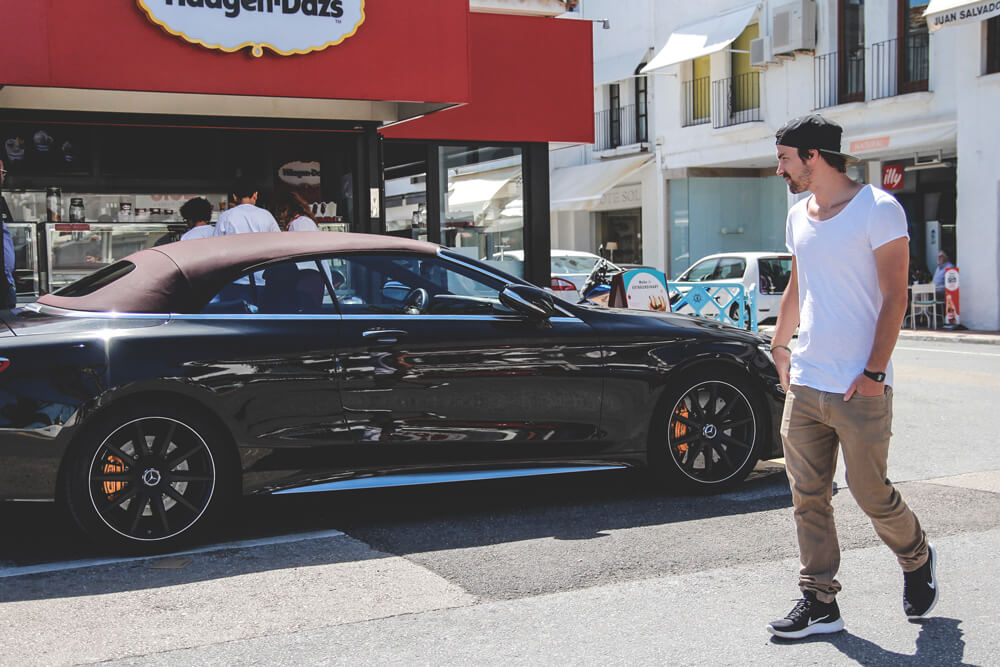
Driving in Andalusia is generally quite easy. The road network is excellently developed. The provincial capitals are connected by motorways. Furthermore, only a few motorways are toll roads, identified by the abbreviation “AP” (autovia or autopista). Toll-free motorways are marked with an “A”.
In addition, drivers in Andalusia are free to use national roads or country roads marked with an “N”. We mostly avoided the toll roads and drove directly along the coast. You don’t save much time by using the motorways either. (Example: between Seville and Cadiz, we paid around €7.20 in tolls for just under 60 km of motorway.)
Important information about driving in Andalusia:
- The speed limit on motorways is 120 km/h
- On country roads, the maximum speed is 100 km/h
- Outside of towns, the speed limit is 90 km/h, and within towns, the speed limit is 50 km/h
4. Long-distance buses and trains
In Andalusia, you can also travel comfortably and easily by train. The modern and efficient rail network takes you comfortably from A to B. In cities, the train or metro station is usually located close to the city center and, in most cases, also connects the airports with popular holiday regions such as Marbella, Malaga, Granada, Seville, and Cordoba.
By train through Andalusia
The Spanish rail network is operated by the state-owned company RENFE. With the international AVE trains, you can also travel to Portugal or even France. Within Spain, you can travel from Andalusia to Barcelona, Madrid, or Valencia. Within Andalusia, you can quickly reach the next town with the ALVIA, ALTARIA, TALGO, AV CITY, and AVANT express trains. The regional Intercity, AVANT, TER, Regional Express, and RAPIDO trains connect the larger cities with the provinces and smaller towns.
They pass through the beautiful landscapes of the national parks, the white villages, rivers, lakes, and hills covered with olive trees. This makes Andalusia a particularly good place to explore by regional train. One of the most beautiful and popular mountain routes in all of Europe runs from Algeciras to Granada via Jimena de la Frontera and Ronda.
By bus through Andalusia
The bus network is also excellently developed. So if you don’t feel like renting a car, you can easily travel by bus. There is usually an hourly bus connection between the major cities in Andalusia. Since train tickets are often more expensive than bus tickets, the bus is the more cost-effective alternative. For example, we paid only €20 from Seville to Malaga; the train would have cost more than €40.
Trains don’t necessarily travel to smaller towns and regions, so the bus is often the only means of transport. Many other places like Nerja, Marbella, or Tarifa can only be reached by bus. The largest bus provider in Spain is Alsa. Alsa also covers a large portion of the bus connections in Andalusia. During peak season, you should book your tickets well in advance.
Important bus connections
- Bus Seville – Málaga
Up to 7 connections daily, travel time: 2:30 – 4:00 h, price approx. €18 to €23 - Bus Seville – Granada
Up to 10 connections daily, travel time: 2:45 – 4:30 h, price approx. €22 to €29 - Bus Málaga – Córdoba
Up to 4 connections daily, travel time: 2:45 – 4:00 h, price approx. €15 - Bus Málaga – Marbella
20+ connections daily, travel time: 0:45 – 1:30 h, price approx. €6 to €9
5. Book Accommodation
We booked accommodation in Tarifa through Airbnb. From Tarifa, we drove to the individual towns and regions by rental car and bus. This way, we didn’t have to constantly move, check out, and check in. Generally, you can also book individual accommodations for each location, just like on a tour. You’ll find a huge selection at Booking.com* and Airbnb*.

In Andalusia, you can find absolutely everything. Whether it’s a hotel, holiday home, vacation apartment, apartment, finca, hostel, private rooms, tents, caravans, or cave dwellings—Andalusia has something for every taste. In the off-season, you can expect to pay up to €30 per night for a simple room. Hostel beds start at just €15 per night. On Airbnb, we paid €660 for a full month in a house (€22 per night). These prices are significantly higher during peak season.
We recommend the off-season (April, May, September, October) either way. It’s quiet, not overcrowded, and prices are significantly lower. Andalusia also gets really busy in the summer, as many locals go on vacation even within Spain. It’s also summer vacation time in Germany and other European countries!
6. Our Highlights of the Andalusia Tour
We’ve marked the top Andalusia attractions on the map below. This way, you can see where everything is at a glance. For an intensive tour, you should allow at least 14 days to avoid just rushing from A to B. If you only have a week, focus on a few highlights.
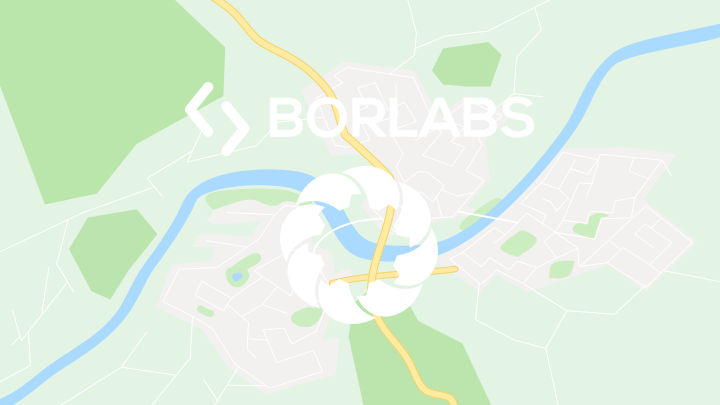
By loading the map, you accept Google’s privacy policy.
Learn more
Load map
The magnificent city of Seville
You should definitely visit the capital of Andalusia. Although Seville is very touristy, there is also a lot to discover. The streets, bars, terraces, and restaurants are bustling with activity. Seville has one of the largest historic centers in Europe, with the striking La Giralda minaret, the cathedral (one of the largest in all of Christianity), and the Alcázar palace.

Among its treasures are the House of Pilate, the Town Hall, the Indian Archives, which houses historical documents from the Americas, the Museum of Fine Arts (the second largest art gallery in Spain), as well as monasteries, parish churches, and palaces. We also particularly liked the Plaza de España and the wooden structure Metropol Parasol, with its fantastic view of Seville. You can find out more here: Our best tips & highlights for Seville.
Lovely hotels in Seville: Un Patio al Sur*, The Nomad Hostel*, Puerta Catedral Apartments* & Santiago 15 Hotel Casa Palacio*.
The white village of Vejer de la Frontera
We really liked Vejer de la Frontera. It’s one of those pretty, white villages in the mountains of Andalusia, also called “Pueblo Blancos.” We simply went with the flow and enjoyed the great weather that day. The narrow streets, the small, hidden shops, the Andalusian flair, and the delicious restaurants made for the perfect combination for a relaxing day trip.
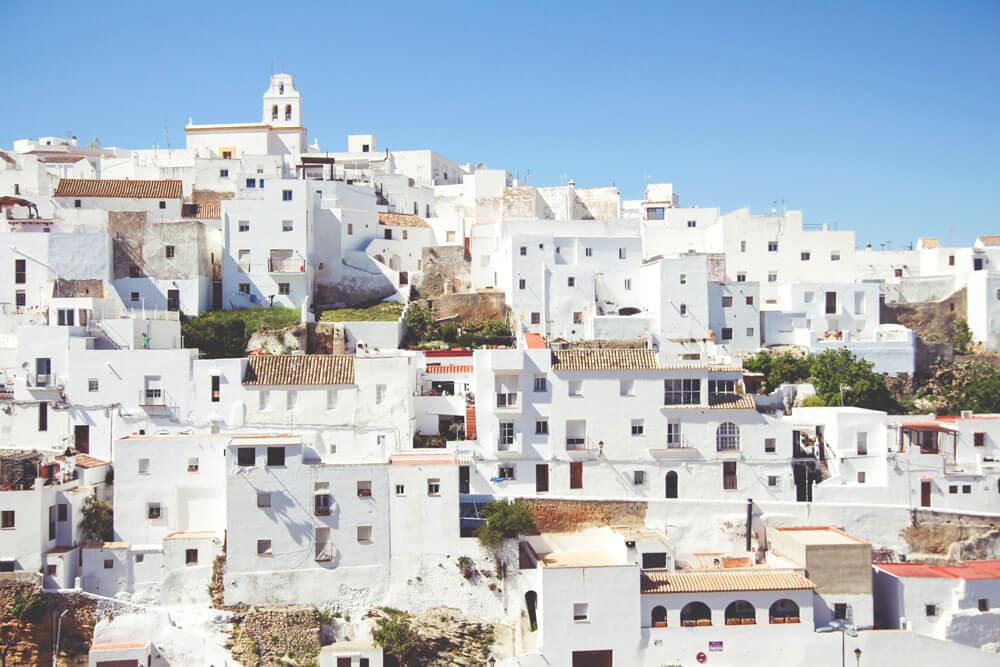
Beautiful hotels in Vejer de la Frontera: La Botica de Vejer*, Hotel Hacienda Montenmedio*, Hotel La Casa del Califa* & Las Palmeras del Califa*.
The beautiful city of Ronda
You shouldn’t miss Ronda either. This city lies at an altitude of around 720 meters. Here you can stroll through the alleys, enjoy a delicious meal, and take some really great photos. The city really impressed us.
Small, winding streets, a beautiful old town, the gorge, the river, and the unique charm are sure to make any heart beat faster. You can find our best tips and highlights for Ronda here.
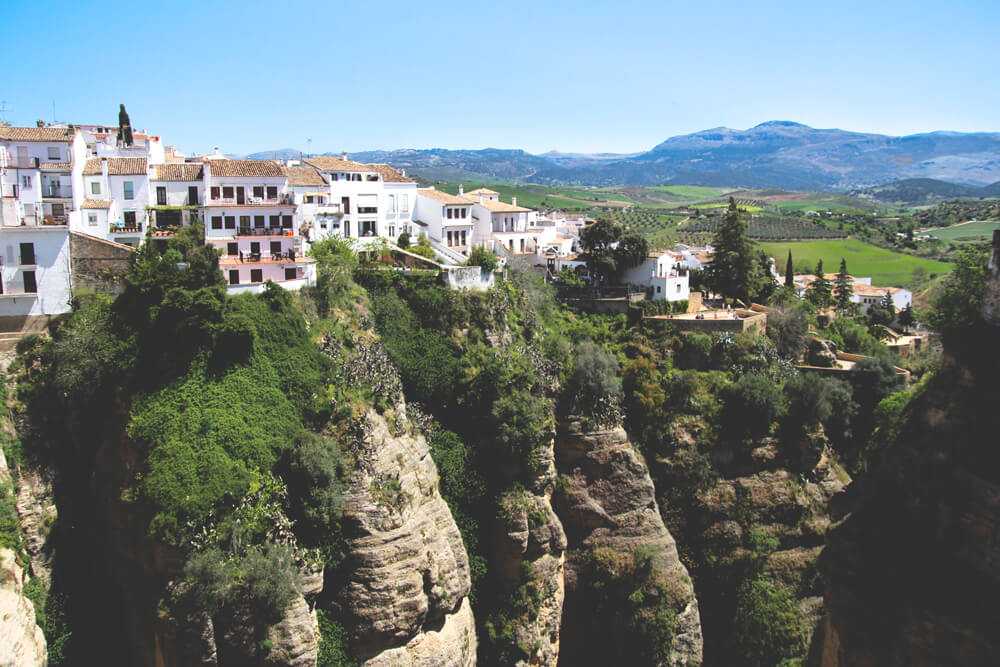
Lovely hotels in Ronda: Ronda Hotel Polo*, Hotel Don Miguel*, Hotel Sierra Hidalga* & Hotel Don Javier*.
On the beach in Conil de la Frontera
Conil de la Frontera is just 50 minutes from Tarifa. If you want to spend a relaxing day at the beach, it’s worth a trip. The town’s narrow streets are lined with restaurants. You definitely won’t go hungry here. You’ll also find some cool shops there. Otherwise, there’s not really much to see there.

Viewpoints at Cape Trafalgar
Before you go, you’ll pass Cape Trafalgar. The beach and the dunes are really beautiful, as is the view from the lighthouse. There’s also a cool little beach bar on the beach with drinks and ice cream. We thought the spot was simply stunning! This place is perfect, especially if you’re looking for a relaxing day at the beach without too much wind!

Detour to Gibraltar
Bobby’s, Guinness, English pubs, pounds sterling, Union Jacks, and the Queen? That sounds like a little adventure here in Spain. Gibraltar is worth a relaxed day trip. The British flair alone, the many British details, the quirky airport, and the beautiful view from Gibraltar’s Rock and Europa Point are anything but “totally boring.”
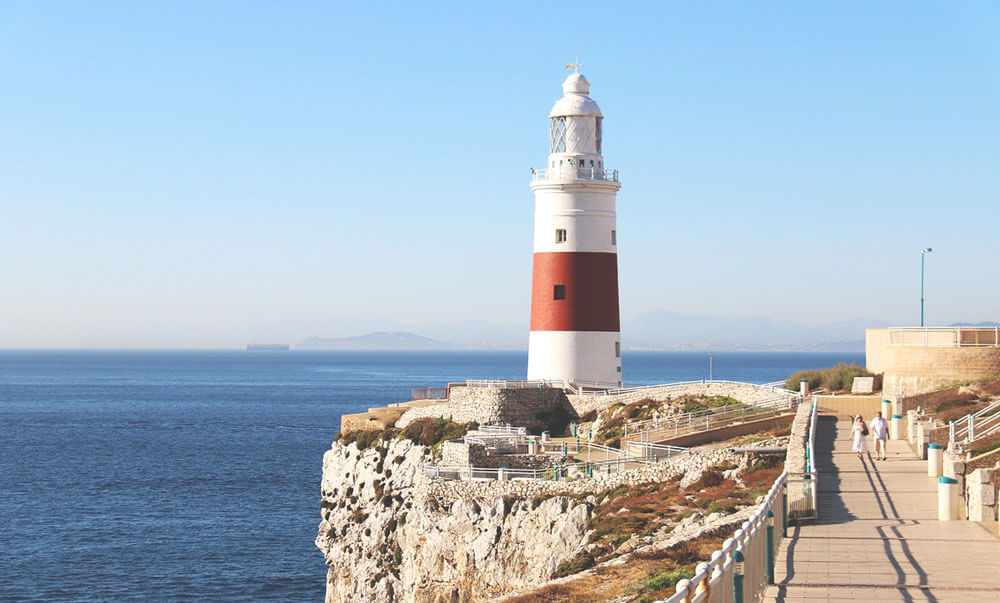
And if you’re lucky, you might see a plane or two take off or land. We had checked the airport’s website beforehand and were able to watch a British Airways plane land. Since we both find the world of airplanes incredibly exciting and interesting, this was a perfect ending for us. Our best tips and information for Gibraltar can be found here.
Chic Marbella
Of course, a stop in Marbella was a must. We wanted to take a closer look at the world of the “rich and beautiful.” And the city lived up to its reputation: huge yachts, extremely expensive cars, and many luxury boutiques. But Marbella has much more to offer.
As you stroll through the old town, you’ll no longer notice the glitzy world. Here you can let yourself go and enjoy the typical Spanish flair to the fullest. You can read all about Marbella here.

Beautiful hotels in Marbella: Hotel San Cristóbal*, Hotel Doña Catalina*, Barceló Marbella* & Senator Marbella Spa Hotel*.
Our favorite Tarifa
What can we say? WE LOVE TARIFA! For us, this place is one of our favorite places in the world. It’s so relaxed, casual, and cozy. The old town captivates with its incredible charm and coziness, many small shops, great cafés, and kitesurfers. The beach is one of the longest and most beautiful in all of Andalusia.
There are only a few rocky interruptions here and it stretches all the way up to Portugal. Its pristine beauty is impressive, especially considering the otherwise very built-up Costa del Sol. You won’t see a single sun lounger on the beach here. Not a single one! Click here for our Tarifa Guide.
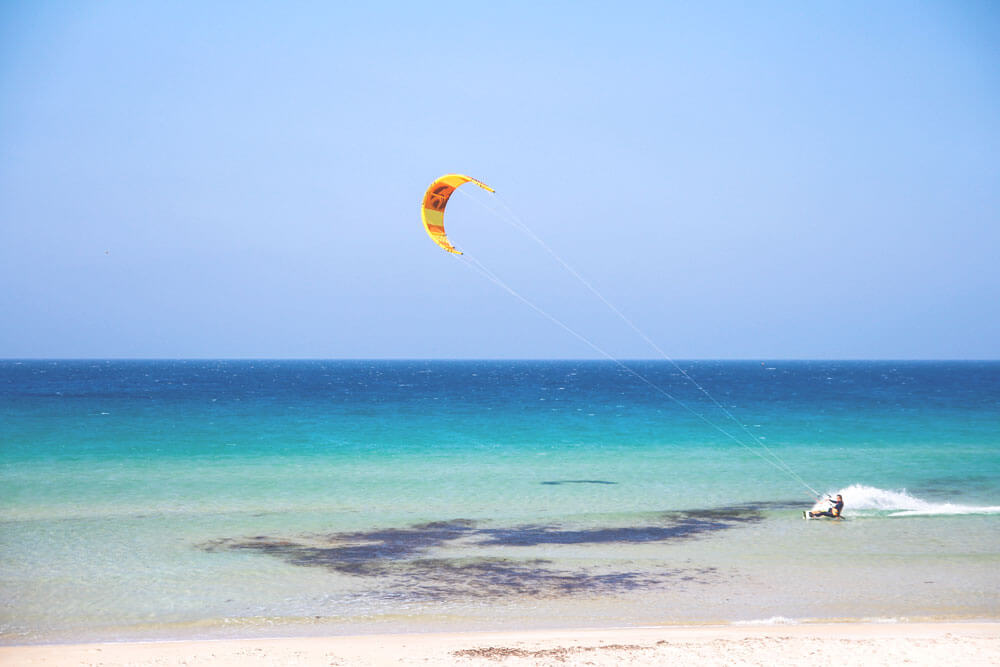
Beautiful hotels in Tarifa: Beach Hotel Dos Mares*, Mesón de Sancho*, La Cocotera Boutique Hostel* & The Melting Pot Tarifa Hostel & Kite school*.
Detour to Malaga
Malaga was the last city on our tour. Here you can expect a big city flair almost like in Seville. Nevertheless, we found Malaga to be a bit more relaxed and quiet. From the Castillo de Gibralfaro, a castle complex above the Moorish fortress Alcazaba, you have a fantastic panoramic view of the city, the harbor, and the sea.
The Puerto de Málaga is ideal for hanging out by the water, watching the boats and ships, and soaking up that holiday feeling. We also found the Paseo España with its beautiful rose gardens and the old town with its many lovely details very cozy. More about this here: Our best Malaga tips & Highlights.
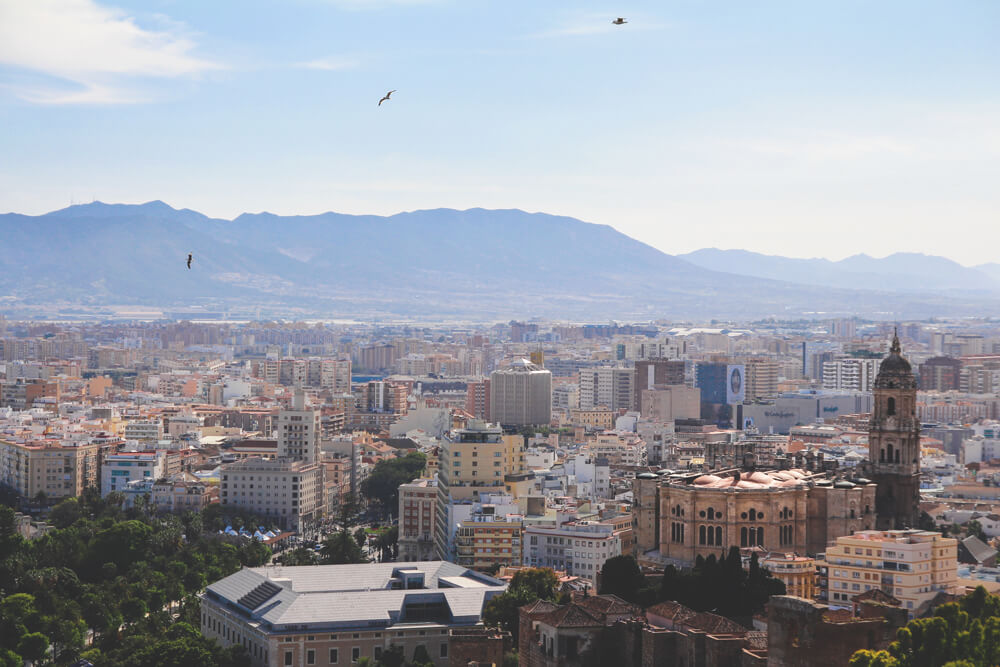
Nice hotels in Malaga: Vincci Málaga*, Hotel Plaza del Castillo*, Ibis Malaga Centro Ciudad*, Hotel Guadalmedina* & Posadas de España Malaga*.
Unfortunately, we didn’t manage to see everything during this trip. But Andalusia isn’t going anywhere. Next time, we’ll definitely visit Granada, Cordoba, Cadiz, Mijas, Nerja, El Torcal, Cominito del Rey, and many other places.
7. Tours and Excursions
You can take various tours in Andalusia or explore the surrounding area. How about a day trip to Malaga, Gibraltar, Tarifa, or Ronda and Nerja? From many cities, you can reach many great highlights in Andalusia in less than 1 to 2 hours. Get your Guide* offers a wide selection of excursions and tours.
8. Costs – Andalusia Tour
We kept a budget for many years and were thus always able to quickly see how our costs broke down in each country and location. Below you will find the individual cost items and the total bill for our Andalusia tour (2017). One month in Andalusia cost us just under €1,493, or just €747 per person. Not bad, is it?
This allowed us to spend a whole month by the sea and visit amazing places. For us, Andalusia is definitely the perfect travel destination for the off-season; we highly recommend it! And it’s by no means expensive in Andalusia, as you’ve just learned. It can be even cheaper if you make more compromises and treat yourself less often.
Andalusia Round Trip Costs:
- Accommodation: €660
- Shopping: €263.21
- Restaurant & Cafe: €258.34
- Rental Car & Fuel: €217
- Bus Tickets: €55
- Parking: €21
- Tolls: €18.10
TOTAL COSTS: €1492.65